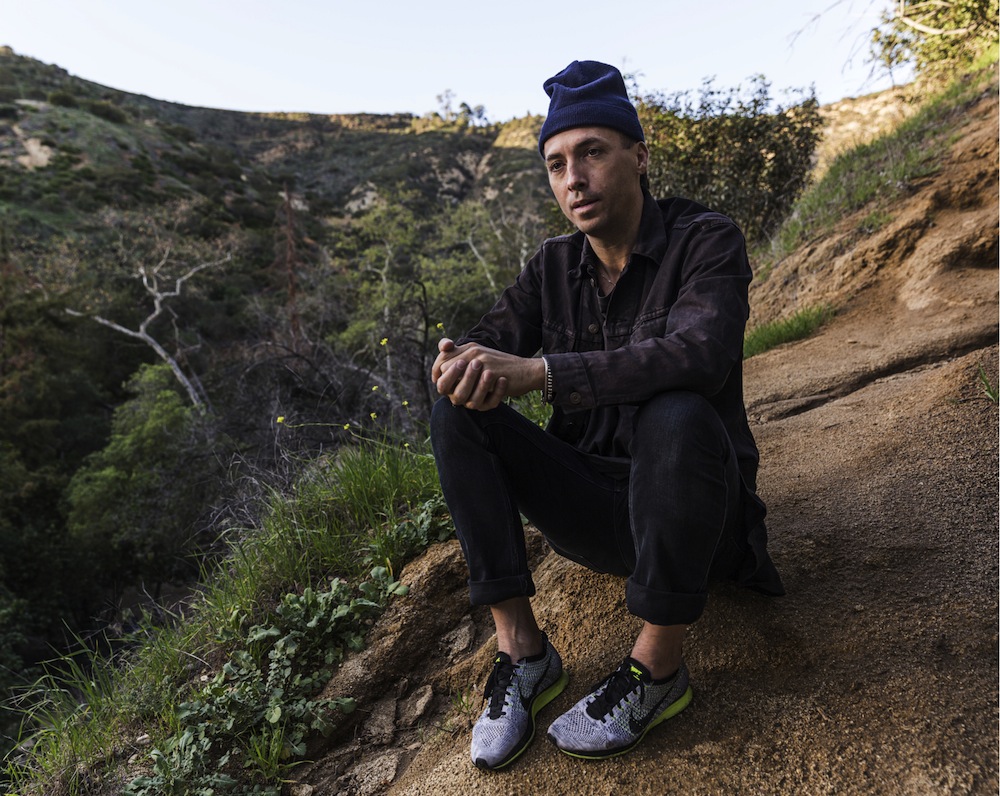Tim Hecker’s Peace of Mind

ABOVE: TIM HECKER. PHOTO COURTESY OF EMILY BERL.
When musician and sound artist Tim Hecker released Love Streams (4AD) in April, it marked a turning point in his artistic trajectory. For the first time in his eight-album discography, Hecker incorporated vocals into the final output. The album’s vocal samples are most certainly electronically distorted and warped, but they are also integral aspects of the experimental soundscape. Originally inspired by 15th-century choral arrangements, Hecker invited Oscar-nominated Johann Johannsson to recompose the ancient scores and then had the Icelandic Choir Ensemble perform the results. Hecker took the choir’s samples and finished recording the album in Reykjavik, the same location in which he completed 2011’s Ravedeath, 1972 and 2013’s Virgins.
More than creating and experimenting with sound, however, Hecker also has roots in visual art. His stage designs are all-encompassing atmospheres that assume the role of immersive art installations. The Vancouver native finds inspiration in the likes of La Monte Young, an avant-garde composer closely tied to the Fluxus and early performance art movements, as well as Olafur Eliasson, an artist regarded for his sculpture and his disorienting fog-filled installations. Having received a PhD from McGill Univeristy and now based in Los Angeles, Hecker continuously disregards the lines that are often drawn between the creation of sound, visual aesthetics, and research.
Shortly after the release of Love Streams and before his performance at Moogfest this weekend, we spoke with Hecker over the phone.
EMILY MCDERMOTT: First of all, what is the significance of Iceland for you? You were there for Virgins and Ravedeath 1972 and you recorded Love Streams there as well.
TIM HECKER: There’s some magnetic pull of the place. There’s the weirdness of arriving at that airport with the smell of sulfur as soon as the gate pulls up to the airplane door—the rotten-egg-smell of the volcanic water. Something about it makes me want to go back every year. What primarily brings me there is friendship and people who have been on my records and helped me over the years. It’s a place where you remember that you’re there to work; it’s a musical place and you’re there on a musical journey. That’s inspiring because you focus. In my day-to-day life I don’t know what the hell I’m doing all the time. I’m spread out and sketchy and overloaded. When you get away, you remember what you’re doing.
MCDERMOTT: Do you remember the first time you went to Iceland?
HECKER: Yeah, it was Iceland Airways in 2009. Ben Frost, a friend that I’ve worked with on past records, invited me to perform as part of their label’s showcase. I rented a car and drove northwest to this glacier and little hotel by the edge of the sea. It was like I was the only person in the hotel. I sat in the restaurant, which was just wood beams and battered, and was served a plate of lamb and scallops. I remember having this really weird, special time in this wind-bashed hotel.
MCDERMOTT: Moving to your album, how did you first discover the 15th-century choral works that Johann [Johannsson] reinterpreted? I imagine finding music from the 15th century isn’t the easiest thing.
HECKER: I was listening to a lot of deep religious music, voice music, and came across a few late 15th-century composers. With the eternal stream of online music, it’s a two-second finger type and those sounds can appear in front of your ears. I started treating those materials like plastic and manipulated them and modified them until they took on a life of their own. I worked with the pieces I loved and they were fodder for transformation.
MCDERMOTT: And how did you decide to work specifically with Johann?
HECKER: I just felt like Johann was the right person. I’d been listening to a bunch of his works, and one of his scores had a lot of treated voice, almost a speak and spell voice. I loved how denatured and alien it was, the way he blended that with more traditional orchestral instrumentation and treatments. I also loved the Prisoners soundtrack he did, and Sicario was also being finished while we were working together.
MCDERMOTT: You had considered using vocals on your last album but decided it wasn’t quite right. Why did now feel like the right time to bring vocals into your process?
HECKER: I tried working with vocals before but it was all these sampled cheesy string and choir pads. It felt too forced. It didn’t sit right. This time, I was recording voices and working with it as this liquid, sculptural content really early on, instead of working with it in a superficial way as samples. I wanted to begin with it and work with it throughout, rather than as an afterthought or as the icing on a cake I’d already made.
MCDERMOTT: What was one of the biggest struggles you faced because of working with vocals?
HECKER: How to deal with the voice—how to treat it; how to present it; how to ride the line between clarity, revelation, and acceptance of the voice being uttered, and denial or confusion or obfuscation of that. It’s a question of how you treat the sound, how you process it, how you deal with it effectively.
I tried things like rap liturgical, where I would chop up mixtape-style forms of Rick Ross in a cathedral, jamming off synthesizers, and that didn’t work. [laughs] I tried a whole bunch of whack ideas that effectively hit the wastebin. At the end, I came to a point where this delicately revealed/obfuscated voice, or companions of voices, became integrated into the song. I felt empowered by working with these things I had blocked off, like conventional song tropes, problems with rhythm and voice, and meaning. I realized that I don’t need to push the line of obfuscation as hard as I used to in the past. It became open to being a piece where things are as they are, and not needing to transform them to an unknowable or an alien state. There’s more of a state of grace with that.
MCDERMOTT: Did the choir members know their voices were going to be altered so much?
HECKER: Yeah, we gave them a bit of a brief: You’re singing the score, but you’re primarily paint that I’m going to smear around and blowtorch, and dump hair, cut up piano strings, and cigarette butts on. This is not some purist session that needs to be perfect. What’s more important is the way you express yourself. How would a dead person sing? Or, I made this joke, “What would Chewbacca do if he swallowed a trumpet?” Try to do that, or try to imagine you’re overloaded with sleep medication or cold medication and you’re tripped out. How would that go?
MCDERMOTT: Usually a choir is so rigid and everyone has to sound unified, so how did they react to those instructions?
HECKER: That’s where Iceland comes in. The beauty is that half of these people were hungover and the other half were eager to do this. They wanted something a bit more playful, where they would have a greater deal of improvisation and freedom to express themselves, versus being overloaded with the rigor of a conductor who’s going to come in and tame them. It was fun and easy, but they’re also highly professional and technically trained. Maybe a choir in New York wouldn’t be very loose, not able to do that, right? You have to find the right choral ensemble that is loose.
MCDERMOTT: I also want to ask about the video for “Black Phase.” Where did the footage come from and what was your role in its creative direction?
HECKER: I worked with a friend on that. We discussed the record a bit, and what was emerging when I was finishing it was this vaguely Chinese theme about the Chinese dream and these choirs. In China last year, three different choirs celebrating the Chinese dream had their stages collapse by accident, 80 people plummeted. I don’t think many or any died, but it was this metaphor that was very potent for me. I was also obsessed with Mongolian downhill skiing and a few other things while making the music, so [for the video] we had a dancer dancing the castrati melancholic—I don’t know what to call it—revelry or something. I just let him go crazy with those general thematics. It’s color layers and pretty obfuscated, but that’s essentially what it is.
MCDERMOTT: I read that your performances and stage sets aren’t really inspired by the music, but rather by La Monte Young and Olafur Eliasson. What role does visual art play in your vision, both musically and aesthetically?
HECKER: It’s hard to talk about this shit without sounding pretentious, but the reality is I draw as much from music as I do from visual art. I’m deeply versed and involved in those worlds. That’s the language I’m comfortable with, it’s the language that gives me great inspiration. I always ask how a conceptual photograph or abstract painting would be sonified, what would it be musically? That’s given me a lot of food for thought over the years, and still does. I had this vision the other day of future music and I imagine these weird, shifting, overlaid translucent layers, and the music was kind of obvious, based on a vision that was primarily visual.
In terms of the stage set, I was deeply inspired by La Monte Young’s Dream House, always and forever. There’s also a Japanese fog sculptor, and Olafur Eliasson’s fantastical pink fog room was a point of interest. I was interested in pushing some of these spaces a bit further, and then making it more about the music than the spaces—making the music really loud and overpowering, but you can’t see the speakers, you don’t know where you are in a light field that really overwhelms you at points, and that acts as a counterpoint for the music
MCDERMOTT: You’ve been asked time and time again when you first became interested in music growing up, but what about art? Do you remember the first time you experienced a piece of art that inspired you?
HECKER: My parents are high school art teachers. So I grew up in this world of art, but I also grew up in this disavowal of art as total bullshit because my dad taught art but all he cared about was Monday night football and reading cheap spy novels. [laughs] The opposite of a high modernist. I grew up with this tongue-in-cheek deepness, but also a deep disavowal of that art world of bullshit. I came back into art on my own terms, maybe in my 20s. It wasn’t a conscious thing. It just kind of happened when I was out of the texts, out of school. Studying philosophy, you encounter works and at some point I did a lot of art history, but there’s just points in your life when you zone in hard on things. That happened to me with art, for sure.
MCDERMOTT: In a previous interview, you were quoted saying, “foster the child in you always, and that’s a challenge that comes with time.” What do you do that helps create these childlike moments?
HECKER: That’s a tough one because it’s easier said than done. It’s a battle with your rational brain that threatens to take over, to keep that voice of reason, structure, and understanding at bay and go into a space where you’re not aiming for any outcome—just zone into creating something where you’re not thinking, “is this an album piece, is this going to be used for something?” It’s like, who cares? It’s really hard after a while to get to those spaces where you’re just tinkering or playing or creating without it having to be for something. It’s a fight to do that, and not always easy.
For this record, it was going to Iceland. Before I went, I had a bunch of shitty tracks I was half working on. I wasn’t ready to be there, I wasn’t prepared enough, but those spaces of intentional unpreparedness, having no expectations, and an empty mind, those third-eye kind of zones are some of the best. It’s hard to cultivate that. For a writer it’s the same thing. Certain music might open up that third eye where the text just pours out of you, but it mostly comes from meditative states—not other work so much as from inside your own mind and affording yourself that space of peace.
TIM HECKER WILL PLAY AT MOOGFEST THIS WEEKEND IN NORTH CAROLINA. FOR MORE ON THE ARTIST, VISIT HIS WEBSITE.






